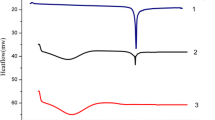Abstract
Chitosan/Carbopol®971NF (poly acrylic acid) interpolymer complexes were prepared in pH 3.0, 4.0, and 5.0 medium to control the ratio of chitosan and Carbopol®971NF in the interpolymer complex. FT-IR analysis confirmed that the mechanism of complexation involved an electrostatic interaction between the NH +3 of chitosan and COO− of Carbopol®971NF. An increase in the pH of the preparation medium was accompanied by an increase in the ratio of chitosan in the chitosan/Carbopol®971NF complex. The maximum yield of interpolymer complexes prepared at pH 3, 4, and 5 (IPC3, IPC4, IPC 5) were obtained at ratios of 1/10, 1/5, and 1/4 (chitosan/Carbopol®971NF), respectively. At pH 1.2, the overall drug release from IPC tablets did not show significant differences. However, at pH 6.8, the rate of drug release from the IPC5 tablet was higher than that from the IPC4 tablet. The release rate from the IPC3 tablet was observed to increase with time. The release mechanism was increasingly dominated by the relaxational contribution in the order of IPC3, IPC5, and IPC4 at pH 6.8. The diffusional contribution was dominated only in the early stage of drug release and the relaxational contribution gradually increased with time.
Similar content being viewed by others
References
Ahn, J.-S., Choi, H.-K., Chun, M.-K, Ryu, J.-M., Jung, J.-H., Kim, Y.-U., and Cho, C.-S., Release of triamcinolone acetonide from mucoadhesive polymer composed of chitosan and poly(acrylic acid) in vitro. Biomaterials, 23, 1411–1416 (2002).
Chavasit, V., Kienzle-Sterzer, C., and Torres, J. A., Formation and characterization of an insoluble polyelectrolyte complex: Chitosan-polyacrylic acid. Polym. Bull., 19, 223–230 (1988).
de la Torre, P. M., Enobakhare, Y., Torrado, G., and Torrado, S., Release of amoxicillin from polyionic complexes of chitosan and poly(acrylic acid). Study of polymer/polymer and polymer/drug interactions within the network structure. Biomaterials, 24, 1499–1506 (2003a).
de la Torre, P. M. and Torrado, S., Interpolymer complexes of poly(acrylic acid) and chitosan: influence of the ionic hydrogel-forming medium. Biomaterials, 24, 1459–1468 (2003b).
Donini, C., Robinson, D. N., Colombo, P., Giordano, F., and Peppas, N. A., Preparation of poly(methacrylic acid-g-poly (ethylene glycol)) nanospheres from methacrylic monomers for pharmaceutical applications. Int. J. Pharm., 245, 83–91 (2002).
Ju, H.-K., Kim, S.-Y., Kim, S.-J., and Lee, Y.-M., pH/temperature-responsive semi-IPN hydrogels composed of alginate and poly(N-isopropylacrylamide). J. Appl. Polym. Sci., 83, 1128–1139 (2002).
Kim, S. J., Lee, K. J., Kim, I. Y., Shin, D. I., and Kim, S. I., Temperature and pH-response swelling behavior of poly(2-ethyl-2-oxazoline)/chitosan interpenetrating polymer network hydrogels. J. Appl. Polym. Sci., 99, 1100–1103 (2006).
Langer, R. and Peppas, N. A., Advances in biomaterials, drug delivery, and bionanotechnology. AIChE. J., 49, 2990–3006 (2003).
Lee, I. and Peppas, N. A., Prediction of polymer dissolution in swellable controlled-release systems. J. Control. Release, 6, 207–215 (1987).
Nunthanid, J., Laungtana-anan, M., Sriamornsak, P., Limmatvapirat, S., Puttipipatkhachorn, S., Lim, L. Y., and Khor, E., Characterization of chitosan acetate as a binder for sustained release tablets. J. Control. Release, 99, 15–26 (2004).
Noble, L., Gray, A. I., Sadiq, L., and Uchegbu, I. F., A non-covalently cross-linked chitosan based hydrogel. Int. J. Pharm., 192, 173–182 (1999).
Park, S.-H., Chun, M.-K., and Choi, H.-K., Preparation of an extended-release matrix tablet using chitosan/Carbopol interpolymer complex. Int. J. Pharm., 347, 39–44 (2008).
Peppas, N. A. and Sahlin, J. J., A simple equation for the description of solute release. III. Coupling of diffusion and relaxation. Int. J. Pharm., 57, 169–172 (1989).
Pretsch, E., Buhlmann, P., and Affolter, C., Structure determination of organic compounds: Tables of spectral data, 3rd Ed., Springer, NY, pp. 245–312, (2000)
Ritger, P. L. and Peppas, N. A., A simple equation for description of solute release I. Fickian and non-fickian release from non-swellable devices in the form of slabs, sphere, cylinders or discs. J. Control. Release, 5, 23–36 (1987).
Tien, C. L., Lacroix, M., Ispas-Szabo, P., and Mateescu, M. A., N-acylated chitosan: hydrophobic matrices for controlled drug release. J. Control. Release, 93, 1–13 (2003).
Author information
Authors and Affiliations
Corresponding author
Rights and permissions
About this article
Cite this article
Lee, MH., Chun, MK. & Choi, HK. Preparation of Carbopol/chitosan interpolymer complex as a controlled release tablet matrix; effect of complex formation medium on drug release characteristics. Arch. Pharm. Res. 31, 932–937 (2008). https://doi.org/10.1007/s12272-001-1249-7
Received:
Revised:
Accepted:
Published:
Issue Date:
DOI: https://doi.org/10.1007/s12272-001-1249-7




